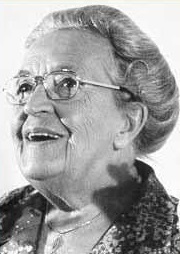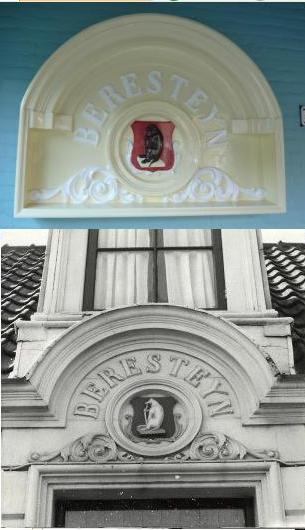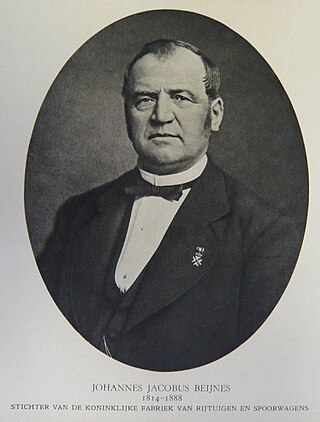
Haarlem is a city and municipality in the Netherlands. It is the capital of the province of North Holland. Haarlem is situated at the northern edge of the Randstad, one of the more populated metropolitan areas in Europe; it is also part of the Amsterdam metropolitan area. Haarlem had a population of 162,543 in 2021.

Cornelia Arnolda Johanna "Corrie" ten Boom was a Dutch watchmaker and later a Christian writer and public speaker, who worked with her father, Casper ten Boom, her sister Betsie ten Boom and other family members to help many Jewish people escape from the Nazis during the Holocaust in World War II by hiding them in her home. They were caught, and she was arrested and sent to the Ravensbrück concentration camp. Her most famous book, The Hiding Place, is a biography that recounts the story of her family's efforts and how she found and shared hope in God while she was imprisoned at the concentration camp.

The Grote Kerk or St.-Bavokerk is a Reformed Protestant church and former Catholic cathedral located on the central market square in the Dutch city of Haarlem. Another Haarlem church called the Cathedral of Saint Bavo now serves as the main cathedral for the Roman Catholic Diocese of Haarlem-Amsterdam.

The Frans Hals Museum is a museum in the North Holland city of Haarlem, the Netherlands, founded in 1862, known as the Art Museum of Haarlem. Its collection is based on the city's own rich collection, built up from the 16th century onwards. The museum owns hundreds of paintings, including more than a dozen by Frans Hals, to whom the museum owes its name. The Frans Hals Museum has two historic locations in Haarlem city centre: the main location on Groot Heiligland and Location Hal on Grote Markt, composed of the adjacent 17th-century Vleeshal and 19th-century Verweyhal. On Groot Heiligland is the 17th-century Oudemannenhuis with regent's rooms. It houses the famous paintings by Frans Hals and other ancient, modern and contemporary art, as well as the museum café. Location Hal regularly hosts exhibitions of modern and contemporary art.

Frans Hals Museum - Hal is one of the two locations of the Frans Hals Museum, located on the Grote Markt, Haarlem, Netherlands, where modern and contemporary art is on display in alternating presentations. The emphasis is on contemporary photograph and video presentations, with the focus on Man and society.

The Hiding Place is an autobiographical book written by Corrie ten Boom with John and Elizabeth Sherrill. It was published in 1971.

The Grote Markt is the central market square of Haarlem, Netherlands.

Elisabeth ten Boom was a Dutch woman, the daughter of a watchmaker, who suffered persecution under the Nazi regime in World War II, including incarceration in Ravensbrück concentration camp, where she died aged 59. The daughter of Casper ten Boom, she is one of the leading characters in The Hiding Place, a book written by her sister Corrie ten Boom about the family′s experiences during World War II. Nicknamed Betsie, she had suffered from pernicious anemia since birth. The oldest of four Ten Boom children, she neither left the family nor married, but remained at home until World War II. She was honored by the State of Israel in 2008 as a Righteous Among the Nations.

Casper ten Boom was a Dutch Christian who helped many Jews and resisters escape the Nazis during the Holocaust of World War II. He is the father of Betsie and Corrie ten Boom, who also aided the Jews and were sent to Ravensbrück concentration camp, where Betsie died. Casper died 9 March 1944 in The Hague, after nine days of imprisonment in the Scheveningen Prison. In 2008, he was recognised as Righteous Among the Nations by Yad Vashem.

The Proveniershuis is a hofje and former schutterij on the Grote Houtstraat in Haarlem, Netherlands.

The Hofje van Codde en Beresteyn is a hofje in Haarlem, Netherlands. The current building is from 1968 and is located on the J. Cuyperstraat, which is named for the architect who designed the Cathedral of Saint Bavo next door, Joseph Cuypers. This hofje is the wealthiest hofje foundation in Haarlem with the most modern facilities for its inhabitants. Poor (devote) Catholic women of Haarlem 60 years and older are still welcome to live there for free.

The Ten Boom Museum is a museum in Haarlem, the Netherlands, dedicated to The Hiding Place, the subject of a book by Corrie ten Boom. The house where the museum is located was purchased and restored in 1983 by the Corrie ten Boom Fellowship, a non-profit 501(c)(3) corporation governed by a board of directors. Mike Evans serves as the chairman of the Board.

Johannes Jacobus, or J.J. Beijnes was a Dutch businessman and entrepreneur who, along with his brother Antonie Johannes (A.J.) Beijnes, was credited with growing the Haarlem factory Beijnes into an international manufacturer of train and tram wagons.

The Grote Houtstraat is a shopping street in Haarlem that connects the Grote Markt to the Houtplein in the direction of the Haarlemmerhout woods.

The Doopsgezinde kerk is a historical hidden Mennonite church dating from the 17th century between the Grote Houtstraat, Peuzelaarsteeg and the Frankestraat in Haarlem, Netherlands.

The Verweyhal is an exhibition space next to the Vleeshal on the Grote Markt, Haarlem. The Verweyhal was built in the 19th century as a gentlemen's society of the former drama society, later a cultural social club, Trou moet Blycken.

The Coomanshof is a former hofje in Haarlem, Netherlands, on the Witte Heren straat.

Return to the Hiding Place is a 2013 film based upon the factual accounting of Hans Poley's World War II encounter with Corrie ten Boom, her involvement in the Dutch resistance and the wartime harboring of Jewish refugees. A non-Jewish fugitive after he refused to pledge his allegiance to the Nazis, Poley was the first person hidden from the Nazis in the Ten Boom House, which is today a museum in Haarlem, Netherlands. The film is adapted, in part, from Poley's book, Return to the Hiding Place (1993), personal recollections, relayed to screenwriter Dr. Peter C. Spencer, and research from the Dutch National Archives. The film is neither a prequel nor is it a sequel to the 1975 film The Hiding Place, instead, it is a congruent accounting of the Dutch underground's resistance efforts from Poley's perspective. It was directed by Peter C. Spencer and starred John Rhys-Davies, Mimi Sagadin and Craig Robert Young.

The Peuzelaarsteeg is a narrow lane in Haarlem, the Netherlands, that connects the Grote Houtstraat to the Frankestraat.

















